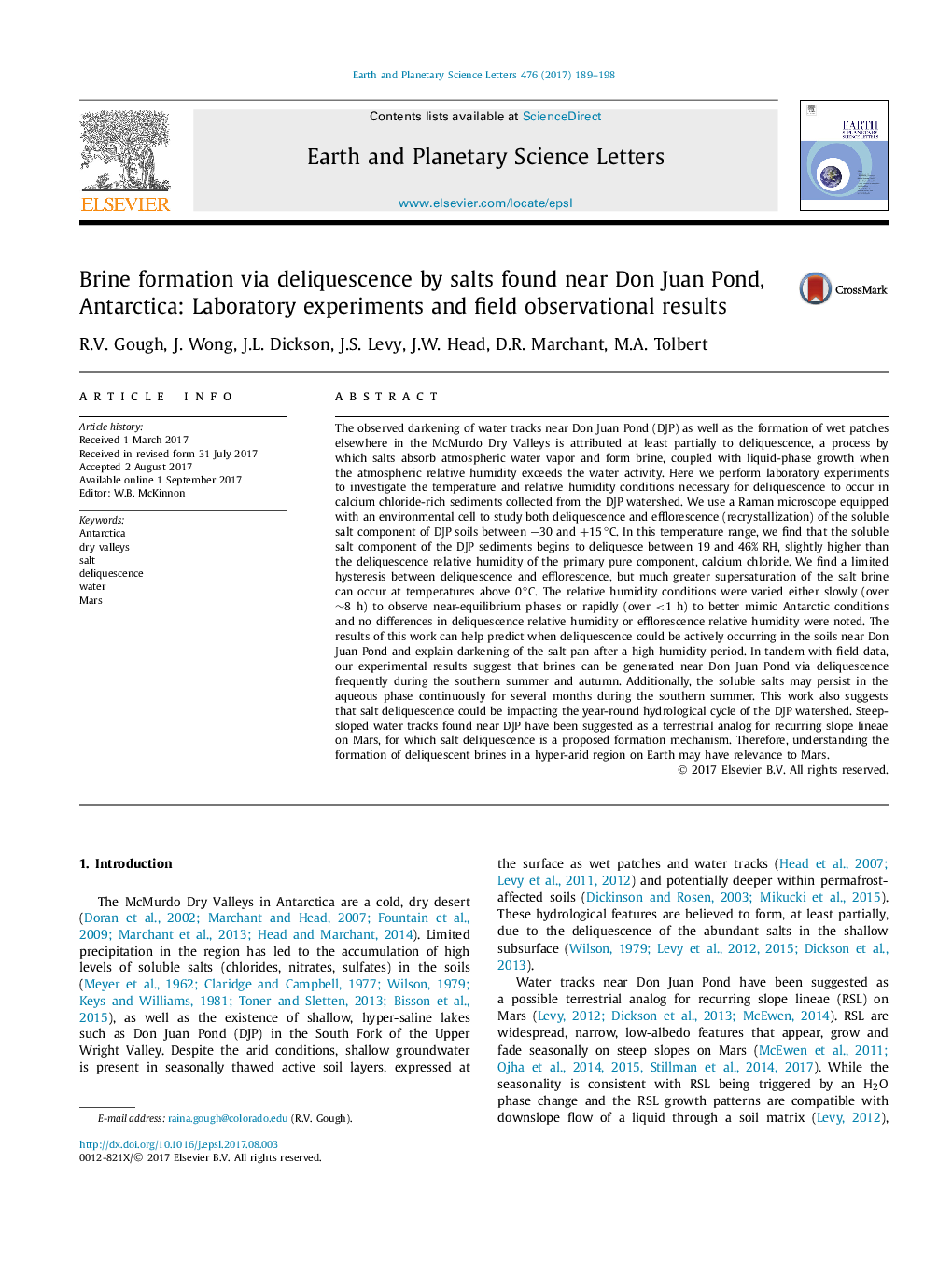| کد مقاله | کد نشریه | سال انتشار | مقاله انگلیسی | نسخه تمام متن |
|---|---|---|---|---|
| 5779647 | 1634680 | 2017 | 10 صفحه PDF | دانلود رایگان |
عنوان انگلیسی مقاله ISI
Brine formation via deliquescence by salts found near Don Juan Pond, Antarctica: Laboratory experiments and field observational results
ترجمه فارسی عنوان
تشکیل نمک از طعم معدنی توسط نمک های نزدیک دون جوان پوند، قطب جنوب: آزمایش های آزمایشگاهی و نتایج مشاهدات میدانی
دانلود مقاله + سفارش ترجمه
دانلود مقاله ISI انگلیسی
رایگان برای ایرانیان
کلمات کلیدی
قطب جنوب، دره های خشک، نمک، رطوبت اب، مریخ،
موضوعات مرتبط
مهندسی و علوم پایه
علوم زمین و سیارات
علوم زمین و سیاره ای (عمومی)
چکیده انگلیسی
The observed darkening of water tracks near Don Juan Pond (DJP) as well as the formation of wet patches elsewhere in the McMurdo Dry Valleys is attributed at least partially to deliquescence, a process by which salts absorb atmospheric water vapor and form brine, coupled with liquid-phase growth when the atmospheric relative humidity exceeds the water activity. Here we perform laboratory experiments to investigate the temperature and relative humidity conditions necessary for deliquescence to occur in calcium chloride-rich sediments collected from the DJP watershed. We use a Raman microscope equipped with an environmental cell to study both deliquescence and efflorescence (recrystallization) of the soluble salt component of DJP soils between â30 and +15â°C. In this temperature range, we find that the soluble salt component of the DJP sediments begins to deliquesce between 19 and 46% RH, slightly higher than the deliquescence relative humidity of the primary pure component, calcium chloride. We find a limited hysteresis between deliquescence and efflorescence, but much greater supersaturation of the salt brine can occur at temperatures above 0â°C. The relative humidity conditions were varied either slowly (over â¼8 h) to observe near-equilibrium phases or rapidly (over <1 h) to better mimic Antarctic conditions and no differences in deliquescence relative humidity or efflorescence relative humidity were noted. The results of this work can help predict when deliquescence could be actively occurring in the soils near Don Juan Pond and explain darkening of the salt pan after a high humidity period. In tandem with field data, our experimental results suggest that brines can be generated near Don Juan Pond via deliquescence frequently during the southern summer and autumn. Additionally, the soluble salts may persist in the aqueous phase continuously for several months during the southern summer. This work also suggests that salt deliquescence could be impacting the year-round hydrological cycle of the DJP watershed. Steep-sloped water tracks found near DJP have been suggested as a terrestrial analog for recurring slope lineae on Mars, for which salt deliquescence is a proposed formation mechanism. Therefore, understanding the formation of deliquescent brines in a hyper-arid region on Earth may have relevance to Mars.
ناشر
Database: Elsevier - ScienceDirect (ساینس دایرکت)
Journal: Earth and Planetary Science Letters - Volume 476, 15 October 2017, Pages 189-198
Journal: Earth and Planetary Science Letters - Volume 476, 15 October 2017, Pages 189-198
نویسندگان
R.V. Gough, J. Wong, J.L. Dickson, J.S. Levy, J.W. Head, D.R. Marchant, M.A. Tolbert,
